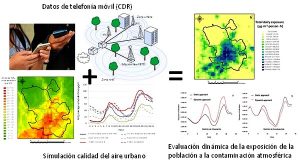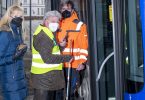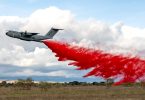Researchers from Universidad Politécnica de Madrid are involved in the development of an innovative methodology to assess the population exposure to atmospheric pollution by using mobile phone data
A group of researchers from Universidad Politécnica de Madrid (UPM) in collaboration with other research centers has carried out a diagnosis and analysis of the quality of the air we breathe in cities based on population dynamics from mobile phone data. The widespread use of this kind of device in our daily life allows us to collect a large amount of geolocation data and thus its real exposure to air pollution throughout the day. Thanks to this new method, researchers have assessed the mobility patterns of citizens and have estimated their real-time exposure to this type of pollution.
Air pollution is one of the greatest challenges cities are facing today and improving air quality is a pressing need to reduce negative health impacts. In order to efficiently evaluate which are the most appropriate policies to reduce the impact of urban pollution sources (such as road traffic), it is essential to conduct rigorous population exposure assessments.
Traditionally, studies about population exposure to air pollution use census data. Therefore, these studies assume that the effects of air pollution depend on the quality of air of the city point where each person’s home is located.
A study carried out by various members of the research group of Environmental Technologies and Industrial Resources (UPM) has developed an innovative methodology to estimate the real exposure based on a population dynamics developed from mobile phone data (call detail records, CDR). The CDR provides user location information when using any network service in his phone and allow researchers to build patterns of mobility of millions of users and finally to estimate the geographical distribution of the citizens at any moment.
One can estimate the real exposure of citizens to air pollution by crossing the mobile phone data with the pollutant concentration data given by high-resolution air quality models. The methodology was tested in the city of Madrid (Spain) to assess the population exposure to nitrogen dioxide (NO2) and the results were compared with the obtained results through traditional methods based on population census.
Rafael Borge, a researcher involved in this study explains, “both methodologies provide similar total exposure data at city scale. However, significant discrepancies were detected at a local level, consequently, we had to add mobility patterns in the population exposure assessments at either district or neighborhood level”. This is important when assessing the impact of air quality policies that can affect city areas such as road traffic restrictions in the city center.
This study is the first step for the use of massive mobile phone data to assess population exposure. This results will allow researchers to identify future lines of research to improve the utility of this combination of technologies.
“We will be able to better understand the contribution of the exposure on each type of environment by classifying the presence of population by activities (home, work, etc.) and travel. This will determine a better assessment of the air population impact we breathe”, the researcher continues. “This new method can be also helpful to assess the impact on health and its applicability in epidemiological studies” Borge concludes.
Picornell, M., Ruiz, T., Borge, R., García, P., de la Paz, D., Lumbreras, J. (2018): Population dynamics based on mobile phone data to improve air pollution exposure assessment. (2019) Journal of Exposure Science and Environmental Epidemiology 29 (2): 278-291. ISSN 1559-064X. DOI: 10.1038/s41370-018-0058-5
More about “Air pollution”






